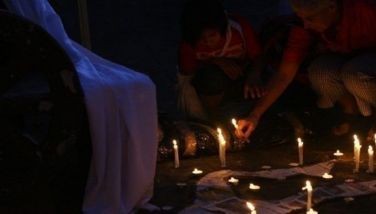What-ifs on Lapu-Lapu and Magellan

What if Ferdinand Magellan – with great help from the translator Enrique of Malacca – did not reach our islands, what would have happened to us? A storm of controversy has blown over the celebration of the 500th year of the Spanish colonization of the Philippines.
One side said that we should be thankful that Spain came and gave us her language, heritage and culture, and the Catholic religion. Another said that we should not be thankful for Spain since it erased our native culture and language, and divided us from each other. It left our people poor and illiterate, with a great inferiority complex.
In an essay called “Magellan, Inquisition and Globalization,” Dr. Felice Noelle Rodriguez and Professor Jomo Kwame Sundaram called Magellan’s visit “globalization’s beginnings.” This history is not mere commerce and trade, but one filled with ”intolerance, exploitation, slavery, violence, aggression and genocide.”
In another work, the great essayist Carmen Guerrero Nakpil called Enrique “the first OFW” in her book, “Heroes and Villains.” Mrs. Nakpil wrote with with a novelist’s eye as she introduced Enrique.
“Sometime in 1508, we first see our hero, a young Malay from the archipelago that would be named Filipinas, clad only in a short ‘sarong’ of indeterminate color, standing under the scorching sun on a crude, wooden platform in the slave market of the Moluccas (now Malaysia). His status as slave is proof that he left his homeland against his will, probably captured from a beach in Eastern Visayas which Muslim pirates raided for the human inventory of their slave trade.”
Magellan bought him as a slave for a few gold coins. The friar in Magellan’s entourage gave him the Christian name of “Enrique,” the name of that day’s saint, and he was brought to Portugal.
Between 1518-1519, Magellan had wanted to lead an expedition to the Spice Islands, but the Portuguese King Manuel did not support him. Through his networks of navigators and astronomers, Magellan went to the young Spanish king, Carlos V, to finance the expedition. He brought a painted globe – and he also brought Enrique, the interpreter, and claimed that Enrique was from the fabled Spice Islands. It was a lie, but Magellan had always been economical with the truth.
Happy that he would be coming home, Enrique was given passage in the flagship, “Trinidad.” A fleet of five ships left the San Lucar de Barrameda in Spain in September 1519. The officers and crew consisted of 260 Spaniards, Portuguese, French, Britons and North Africans.
But disasters and ill-luck hounded the expedition: “inadequate supplies, three mutinies and conspiracies, furious storms, cannibals, giants, violent deaths.” From Spain they sailed around South America, survived glaciers, and finally emerged into the blue immensity of the Pacific Ocean. Supplies ran low and the men began eating rotten biscuits, shoes and rats. They landed in Micronesia and later in Guam, where the natives stole their weapons and provisions.
Finally, after being guided well by Enrique of Malacca, through the tricky route dotted with small islands that he must have visited before, the expedition arrived in Samar on March 16, 1521. But the cliffs were high and they could not land, so they moved to the smaller island of Homonhon. The harbor was safe, and their eyes roved at the sight of luxuriant rainforest and drinking water from a spring.
“Pleasant natives appeared in a boat and gave the mariners coconuts, rice wine and bananas. They moved on to the next island [of Mactan] where campfires lighted up the sky. As the Trinidad approached the shore, Enrique was ordered to communicate with the brown men on the beach. They replied in the same language with shouts of recognition and familiarity. Magellan and the other Europeans in the three black galleons were flooded with relief and gratitude, for, until that moment, they had been painfully uncertain of where they were, or where Enrique had come from. They found magnificent shelter and excellent food (fish, abundant rice, roast pork with gravy) in breezy grass huts, and a native king who was decorated with large chains of gold.”
For this hospitality, the arrogant Magellan demanded that the natives accept his God and his king, and asked for tribute. He repaid their generosity with a scheme to “civilize” and “colonize” them. Enrique was against fighting Datu Lapu-Lapu, that was why he refused to get off the ship.
So Magellan, who walked with a limp because he had earlier fallen off a horse, made the stupid mistake of wading ashore with incomplete body armor. He had refused reinforcements, telling his men that defeating the natives would be a breeze. But they swarmed upon him, lopped off his arms and limbs, and thrust their spears into his body, again and again.
This, the natives seemed to say, is what we do to foreigners who would dare steal our islands.
Enrique also refused to return to Spain with the survivors. The Europeans told him that he was still a slave and the property of Magellan’s widow. But he was already home, in the Visayan Islands. He wanted to remain there, and told the Europeans he was ready to kill, if that was needed, so he could stay in his country and be with his own people.
The Spaniards would return in 1565, with Miguel Lopez de Legazpi, who was more shrewd than Magellan. Thus began 333 years of the brutal Spanish colonization.
In 1957, Rodriguez and Sundaram said that a history teacher in Singapore, Harun Aminurrashid, published a novel to inspire children in newly independent Malaya. The hero was a character based on what was known about Enrique, whom he called Panglima (Commander) Awang.
“Thus, we now have the heroic figure of Panglima Awang. Almost Spartacus-like, the captured slave becomes a hero. Recent portraits as well as a sculpture of Enrique de Malacca by the Malaysian multimedia artist, Ahmad Fuad Osman, also strengthen this image.
“Today, Enrique is claimed by several contemporary Southeast Asian nation states. Some Malaysian historians have reified the fictive Panglima Awang. Malaysian memorialization has involved not only making history from fiction, but also by creating new myths from history… More than anyone else, Enrique has come to symbolize island Southeast Asia, the Nusantara.”
If Magellan did not drop anchor, we would have continued to flourish as prosperous Muslim kingdoms, united by our own language and proud of our own culture, happily trading with Asia and parts beyond.
* * *
Danton Remoto’s novel, Riverrun, was recently published by Penguin Books. It is available at Shopee Philippines and globally at amazon.com
- Latest
- Trending




























